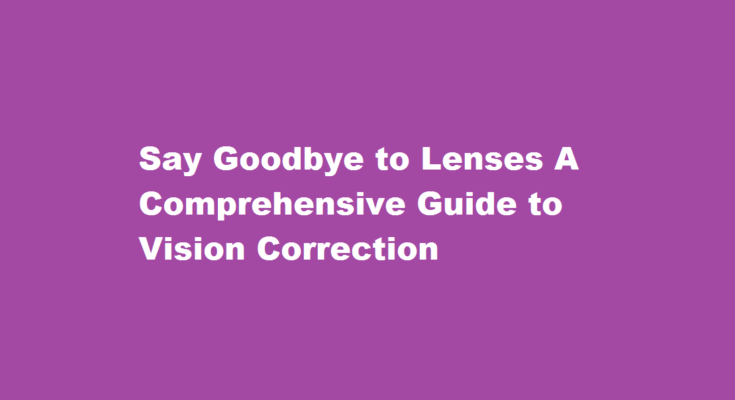Introduction
For countless individuals, contact lenses have been a game-changer in terms of vision correction. However, as convenient as they may seem, lenses come with their own set of challenges, ranging from discomfort and eye infections to the overall cost and maintenance. If you find yourself longing for a lens-free life, fear not! This article provides a comprehensive guide to various vision correction options that will help you bid farewell to lenses and embrace clear, comfortable vision.
LASIK Eye Surgery
One of the most popular and effective ways to get rid of lenses is through LASIK (Laser-Assisted In Situ Keratomileusis) eye surgery. This outpatient procedure involves reshaping the cornea using a laser, correcting refractive errors like myopia, hyperopia, and astigmatism. LASIK offers rapid recovery and a high success rate, providing many individuals with permanent freedom from glasses and contact lenses.
PRK (Photorefractive Keratectomy)
Similar to LASIK, PRK is a laser eye surgery that reshapes the cornea, but without creating a flap. Instead, the outer layer of the cornea is gently removed before the laser treatment. Although the recovery period may be longer compared to LASIK, PRK can be an excellent alternative for individuals with thinner corneas or other conditions that may make LASIK unsuitable.
Implantable Contact Lenses (ICL)
For those not eligible for LASIK or PRK, implantable contact lenses (ICL) can be an effective solution. ICLs are inserted into the eye to correct vision, eliminating the need for external contact lenses. This procedure is reversible, making it an appealing choice for those who may wish to alter their vision correction in the future.
Orthokeratology (Ortho-K)
Orthokeratology, commonly known as Ortho-K, involves using special rigid gas-permeable contact lenses at night while sleeping. These lenses temporarily reshape the cornea, providing clear vision during the day without the need for any eyewear. Ortho-K is particularly beneficial for mild to moderate myopia and can be a great option for children and active individuals.
Refractive Lens Exchange (RLE)
Refractive Lens Exchange (RLE) is a surgical procedure primarily used to treat presbyopia or extreme cases of hyperopia and myopia. During the procedure, the eye’s natural lens is replaced with an intraocular lens (IOL), customized to the individual’s vision needs. RLE can be a life-changing solution for those who are not suitable candidates for LASIK or other vision correction procedures.
Corneal Ring Segments (Intrastromal Corneal Ring Segments)
Corneal Ring Segments, also known as Intrastromal Corneal Ring Segments (ICRS), are small plastic rings implanted in the cornea to correct certain types of vision problems, particularly keratoconus. These rings help reshape the cornea, improving vision and reducing the dependence on glasses or contact lenses.
Natural Vision Improvement Techniques
Aside from surgical options, certain natural vision improvement techniques can be explored to reduce the need for lenses. These include eye exercises, proper nutrition for eye health, and practicing the 20-20-20 rule (taking a 20-second break every 20 minutes and looking at something 20 feet away) to reduce eye strain.
Frequently Asked Questions
What is the best way to correct vision?
Poor vision from refractive errors can often be corrected with glasses, contacts or surgery. Treatments for other eye conditions depend on the cause and the level of severity. It may include eye drops, medications, laser treatments or surgery.
What are 3 very common vision problems?
These refractive errors are the most common eye problems in the U.S. Refractive errors include nearsightedness (myopia), farsightedness (hyperopia) and distorted vision at all distances (astigmatism). These eye conditions can be helped with eyeglasses, contacts or surgery.
Conclusion
There is no one-size-fits-all solution to vision correction, and the best approach for getting rid of lenses depends on various factors, including the individual’s eye health, lifestyle, and specific vision needs. Consulting an eye care professional is crucial to determine the most suitable option. Whether you choose LASIK, PRK, ICL, Ortho-K, RLE, ICRS, or natural vision improvement techniques, the goal is the same – achieving clear and comfortable vision without the hassle of lenses.
Remember, the decision to undergo any vision correction procedure should not be taken lightly. Always thoroughly research and consider the potential risks and benefits before making your choice. With advancements in technology and various options available, the dream of a lens-free life is attainable for many individuals seeking freedom from glasses and contact lenses.
Read Also : Mastering The Art of Optical Illusions Unveiling the Secrets of Perception



